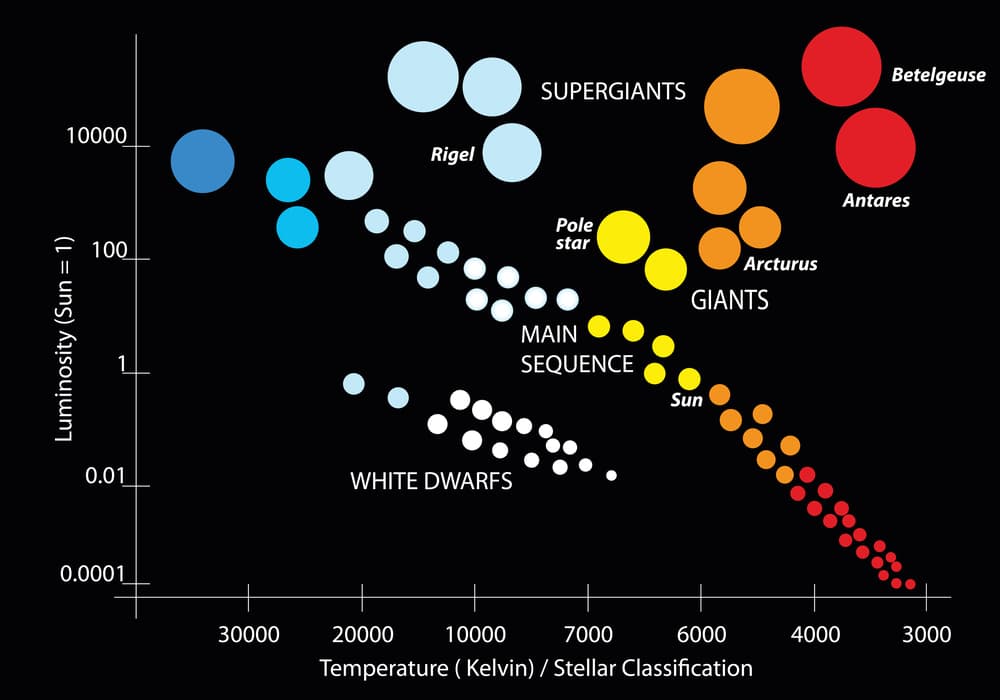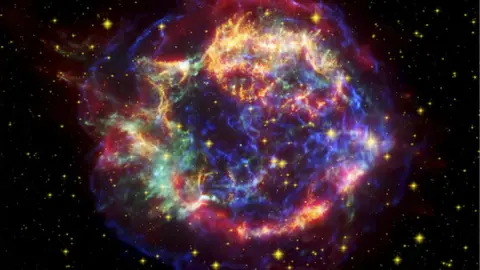List the names of the smallest and largest planet in the solar system.
Mercury - smallest
Jupiter - largest
Why can’t a planet that is too close to its star support life?
A planet that is too close to its star cannot support life because it would be too hot, and liquid water, necessary for life, would not exist.
Draw a diagram of the life cycle of an average star, such as our sun. Label the stages of the life cycle.
Do stars emit light, or do they reflect light from a nearby sun?
They emit light.
How is the universe changing?
Expanding, rate of expansion is accelerating
Identify the object in the solar system all the planets, including Earth, are moving around.
The Sun
What do you think would happen if a meteor collided with another planet without an atmosphere?
No atmosphere to slow it down, large crater
Betelgeuse (BEE-tul-joos) is a star with a surface temperature of approximately 3,500 K and a luminosity of more than 10,000 on the H-R diagram. Use the H-R diagram to compare the characteristics of Betelgeuse to those of our sun. Include the classification of each.
The Andromeda Galaxy is the closest galaxy to the Milky Way. Andromeda contains a concentrated bulge of matter in the middle and arms that spiral outward. What type of galaxy is Andromeda?
Barred spiral

What evidence supports the Big Bang theory’s description of the origin of the universe?
- The present ratio of helium to hydrogen in the universe.
- The distribution of the Cosmic Microwave Background Radiation (CMB).
- Hubble's discovery of the relationship between a galaxy's distance from Earth and its speed.
- The discovery of cosmic microwave background radiation.
- Chemical elements created soon after the Big Bang align with the theory
What is the closest and farthest object from the sun in the solar system.
Mercury - closest
Neptune - farthest
Which of the planets are in our solar system’s “habitable zone?”
Earth and Mars
Which color of star is hotter?

Blue
Correct this statement:
Earth’s solar system is located on the Outer-Perseus Arm, about 13,700 light-years from the center of an elliptical galaxy called the Milky Way.
Earth’s solar system is located on the Orion Arm, about 26,000 light-years from the center of an spiral galaxy called the Milky Way.
Sirius B is a small and dense star that used to be much larger and shone a bright blue. Now it is so dense that even though it is smaller than our sun, it contains the same amount of mass as our sun. Sirius B was the first star of its kind to be discovered.
What type of star is Sirius B currently?
Sirius B is a white dwarf star that orbits the brightest star in the sky, Sirius A, every 50 years.

Which planets are closest to the sun and have rocky crusts, dense mantles, and cores?
Mercury
Earth
Venus
Mars
Why are planets outside of the habitable zone not suitable for life?
Living things need liquid water. The habitable zone is the area in which water can exist as a liquid. If the planet is too close to the sun, the water would boil away. If the planet is too far away from the sun, the water would freeze and turn to ice.
Based on the Hertzsprung-Russell diagram, compare Red Supergiants and White Dwarfs.

Based on the diagram the Red Giants are stars that are large, very bright, and very cold. The White Dwarfs are stars that are very small, not bright, and hot.
What factors or characteristics do astronomers use to classify galaxies as spiral, elliptical, or irregular?
- Spiral galaxies have discernible structure (e.g., spiral arms) and can be more disk-like.
- Elliptical galaxies do not have structure and usually look like balls of stars and dust.
- Irregular galaxies don't fit within either of these categories.
True or False:
The universe formed in a massive explosion called the Big Bang about 13.7 billion years ago and has been expanding ever since.
True
True or false? The Oort Cloud is a spherical region that surrounds our solar system like a shell, thousands of astronomical units away from the sun. It contains some long-period comets.
True
Name three characteristics that allow life to exist on Earth.
Proximity to the sun
Presence of water
Composition of the atmosphere
What stage of the life cycle of a star is the image showing?
Blackhole
What can an exploding star tell astronomers about the universe?
how fast the universe is expanding

AT2021lwx, supernova 8 billion light years away, largest ever found
A spectrograph separates incoming light by its wavelength. Hubble used this instrument to conclude that some galaxies are moving away over time. Which term best describes this phenomenon?
Redshift